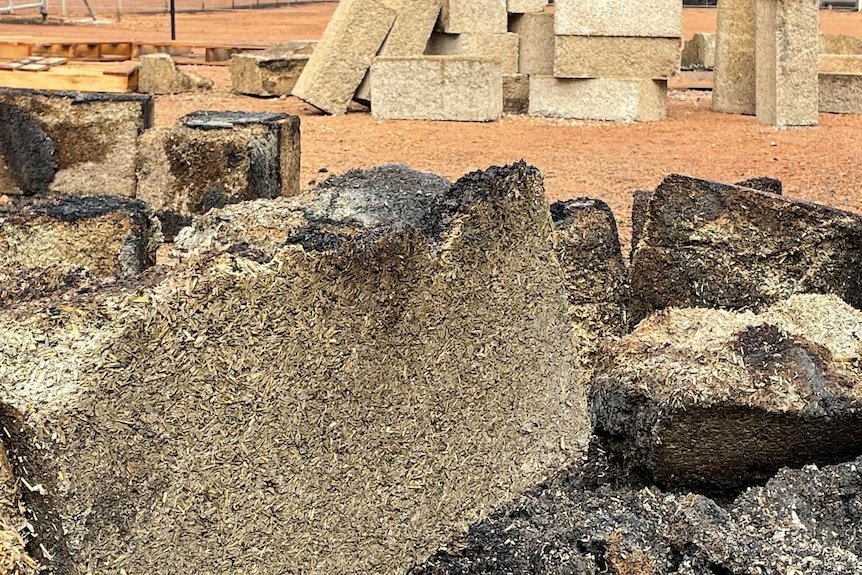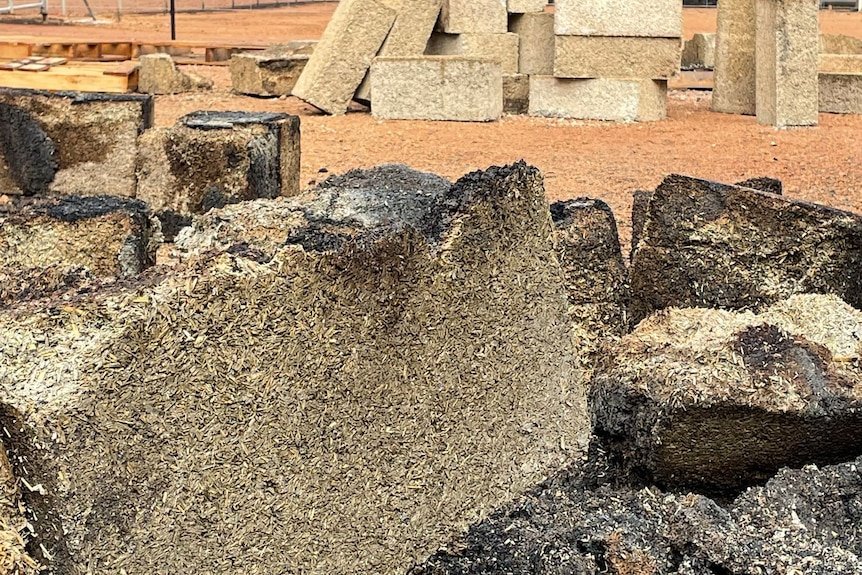Cured hemp blocks (background) at Hemp Squared in Bridgetown, West Australia survived a bushfire Feb. 5 that destroyed the factory and blocks that were partially cured (foreground). Photo courtesy of Hemp Squared Pty. Ltd.

By Jean Lotus
An Australian bushfire this month put the spotlight on the fire-resistant properties of hempcrete blocks, offering a sustainable construction solution for areas in danger of wildfires.
No one died Saturday, Feb. 5 in the mid-afternoon blaze that swept through the village of Bridgetown (pop. 4,500) and evacuated the town about 150 miles southeast of Perth in Western Australia.
But the Hemp Squared Pty. Ltd. block factory in Hester Brook, about a mile outside of town, was destroyed in the fire, founder/owner Iggy Van told HempBuild Magazine. Ninety percent of the company’s stock was lost in the fire, but a stack of fully cured blocks made prior to Christmas survived, Van said.
Subscribe to HempBuild Magazine’s free newsletter
“Interestingly, the blocks that survived were stacked on [wooden] pallets,” Van said. “The pallets burned down, but the blocks did not.”
Hempcrete, or hemp-lime insulation is fire resistant because of the lime in the mixture. The combination of hemp, lime and water cures after about six weeks into a stone-like material that regulates temperature and humidity when used as a “monolithic” insulation envelope in wall assemblies.
Hemp masonry homes are encouraged by the Australian government’s Department of Energy, as sustainable building solutions in a country where bushfires have destroyed thousands of homes causing billions of dollars in damage.
Hemp block ‘nano factories’
A former tech manager with a background in electrical engineering, Van turned hemp-building entrepreneur when he became frustrated building his own house on a steep hillside that was hard to reach with traditional building machinery and equipment.
In January, Hemp Squared received a $75,000 economic development grant from the government to upgrade their facilities to produce 200,000 blocks per year, about enough to build 60 hemp masonry homes in Australia.
“It’s been an exciting month,” Van noted, wryly.
Like some companies in the United States, the company has used hemp hurd imported from France until enough of a local supply is produced, Van said. He hopes Hemp Squared will help provide a market for hemp hurd in the slowly evolving Australian hemp growing industry.
The company’s business model consists of transportable “nano-factories” that can be brought to a building site, or have hemp raw materials delivered separately.
“It’s a modular approach,” Van said. “We can stuff it full of hurd and binder and take it to a site. The only thing we require from the customer is that there is a large shed where we can put the blocks to dry,” he said.
Bridgetown bushfire Feb. 5, 2022. Photo courtesy of Dunsborough Volunteer Bush Fire Brigade
Shift in the wind
The town of Bridgetown was spared from destruction by a shift in the wind and a light rain the next day that helped the Dunsborough Volunteer Bush Fire Brigade put out the blaze.
Click here to go to our FREE online community.
Along with the Hemp Squared manufacturing facility, a golf course clubhouse was also destroyed by the fire, and Van hopes the town can build community by gathering together to rebuild – with hemp blocks.
“That’s an opportunity from all this. That’s the silver lining,” Van said.
Please Support Our Classified Advertisers
(To find out more about advertising CLICK HERE).
Training and Education
Publications
-
Hemp Building Directory 2022 – Guide to the International Hemp Building Industry
-
Available Now! “Hemp Buildings – 50 International Case Studies” by Steve Allin
Hemp Hurd (shivs)/Hemp Fiber/ Hemp Microfiber
Hempcrete installers/Insulation subcontractors
Lime Binder
Hemp Batt Insulation/Supplies
Green Builders
Hemp Building Engineers
Hemp Genetics
Professional Associations
Events
Originally published February 25, 2022 on Hemp Building Mag
https://www.hempbuildmag.com/home/hemp-blocks-survive-australian-bushfire


